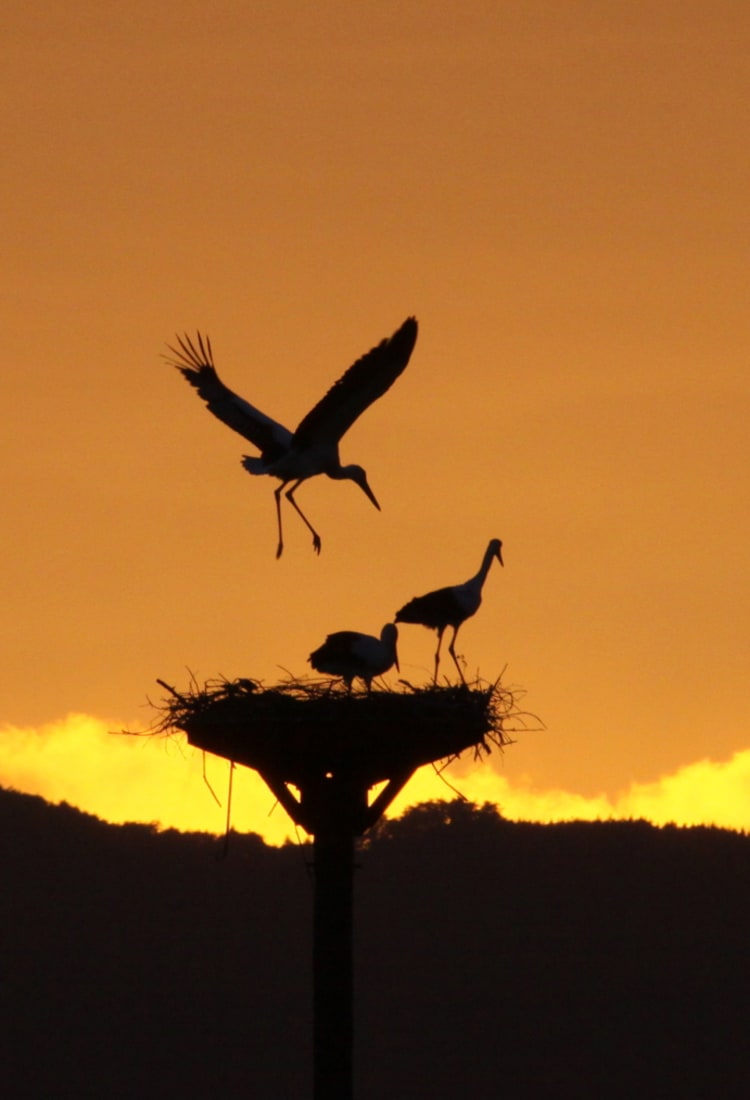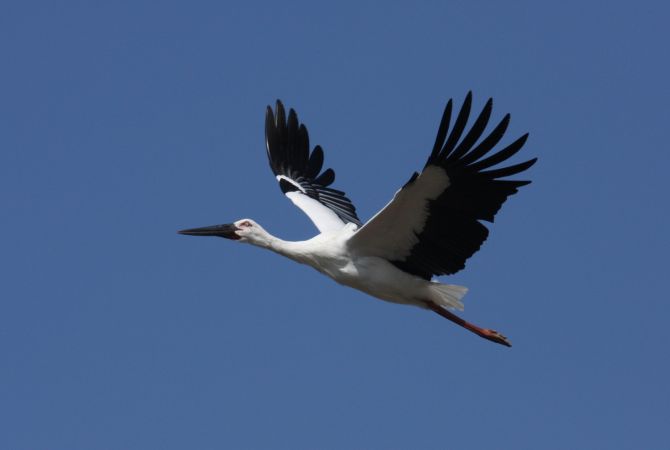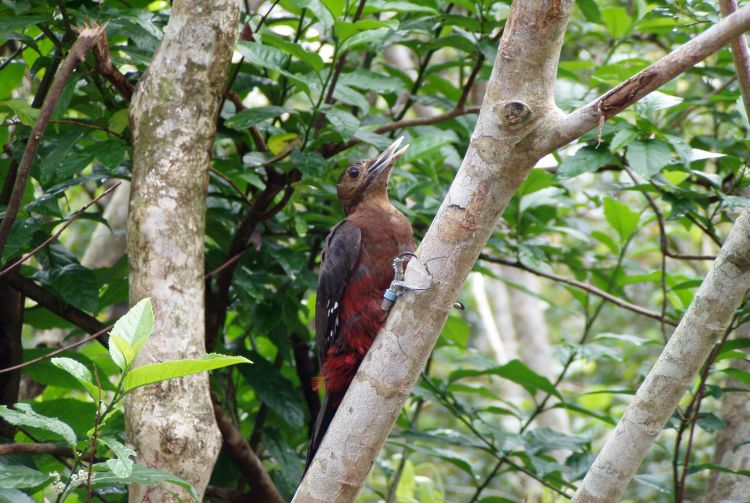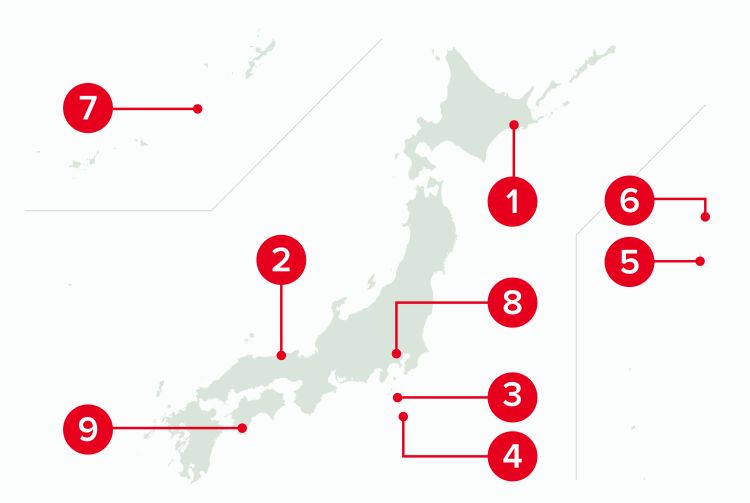

REISEFÜHRER Bird-Watching in Japan Rare and spectacular sights await keen birders
Incredible natural diversity and dedicated conservation efforts make Japan a haven for endemic species and migrant birds.
Not all of Japan's tourists arrive through its major airports. The country hosts many migrant visitors of the feathered variety each year. Shorebirds arrive in spring and autumn, warblers and flycatchers in summer, and ducks, buntings and finches in winter. It's also home to plenty of endemic species — many of which are rare and exceptionally beautiful, putting Japan at the top of many bird enthusiasts' wish list. Japan stretches from the subarctic to the subtropical climate zones, and this diversity paired with its four seasons and varied terrain means there are welcoming environments for a wide variety of wildlife.

Red-crowned cranes are best known for their elaborate courtship dance
Balletic birds
The red-crowned crane, known locally as tancho, are considered a symbol of happiness and longevity. These highly-prized birds have appeared in Japanese art for centuries, and you'll often find them on bridal kimono, sake bottles and paper screens. They are perhaps best known for the seemingly choreographed mating dance they perform between February and March. Hokkaido is one of the best places in the world to witness this spectacle, as over half of the world's dwindling red-crowned crane population live there. Strong conservation efforts in the region are reviving the population after being hunted to the brink of extinction. Hokkaido's Kushiro Marsh is especially interesting to bird-watchers due to their mostly non-migratory behavior, only moving 150 kilometers for the winter season, which is unique among the species. There are over 300 species of wild birds in Hokkaido — many of which migrate from Siberia during the winter. Hokkaido is home to around half the bird species in Japan, which makes it the most desirable place to visit for many bird-watchers in Japan.


Once extinct, the wild population of Japan's Oriental storks is beginning to flourish
Against all odds
The storks in Toyooka, a town on Japan's coast, around two and a half hours north-west of Kyoto , are another coveted sighting for bird-watchers. The region devotes extensive resources to reviving Japan's once extinct wild Oriental stork population. The last known stork died here in 1971 and, in 1985, a new mustering of storks was introduced from Russia. Organic rice farming in the area ensures crops are raised in paddy fields that are abundant with the creatures storks feed on, and the subsequent yield, known as “Konotori-hagukumu-okome“ (stork rice) is considered to be a premium product.
Building a future for Japan's birds
Protecting birds' habitats is a priority, and there are 160 designated Important Bird Areas (IBAs) in Japan, identified by BirdLife International to ensure their conservation. It identifies three Endemic Bird Areas in Japan—the Izu Islands , Ogasawara Islands and Nansei Islands.

Owston's tit is endemic to the southern Izu Islands
Izu Islands
The stars of this cluster of islands as far as bird-watchers are concerned are Hachijojima and Miyakejima. Izu thrush make their homes in the gardens and forested areas of Hachijojima, where keen birders will also find phylloscopus ijimae and Izu robins. Other birds to look out for are white thrushes, Pleske's warblers, Pacific swifts and white-throated needletails. On Miyakejima, you'll find most of the same species as well as Owston's tits, Japanese black woodpigeons, Japanese pygmy woodpeckers, Eurasian wrens and Japanese white-eyes. Hachijojima can be reached in around ten hours by ferry from Tokyo, and Miyakejima can be reached in around six and a half hours.

Japanese white eyes are found all over Japan
Ogasawara Islands
It doesn't get much more remote than this. Known as the Galapagos of the Orient, this UNESCO World Heritage site is an archipelago that is technically part of Tokyo, but it will take you around 24 hours of ferry travel to reach. There's no airport and the ferry only runs four times a month, giving nature the space it needs to thrive. The islands are a favorite for birders because of the Bonin honeyeater, also known as the Bonin white-eye, a songbird endemic to Hahajima , one of the islands in the chain. There are also brown boobys and wedge-tailed shearwaters on Minamijima and a breeding ground for the rare Bryan's shearwater on Higashijima. Even the ferry ride offers a fantastic opportunity for birding, with red-footed boobys, Arctic skuas, Laysan albatrosses and Bonin petrels known to fly in the area.

Pryer's woodpecker, also known as Okinawa woodpecker is endemic to the region
Nansei Islands
This island chain stretches between Kyushu and Taiwan. Its subtropical environments attract species you won't find elsewhere in Japan, such as the cinnamon bittern. It's also home to species unique to these islands, including the Amami woodcock, and northern Okinawa's rare Pryer's woodpecker. But, no ornithologist should travel to the main island of Okinawa without trying to seek out the Okinawa rail. This reclusive, flightless bird was discovered in 1981 and is a prized spot for keen birders.

The flightless Okinawa rail is a rare find, but ornithologists have their best chance of spotting one in the main island of Okinawa
Rare sightings
After becoming extinct in Japan in 2003, the crested ibis was reintroduced from China. Artificially bred pairs were released into the wild on Sado Island off the coast of Niigata in 2008. Since then, the population has shown promising signs, with more than 40 ibises born in the wild.

Brown boobys are often seen around the Izu Islands, Kyushu and the Ogasawara Islands
Urban and mainland sightings
But bird-watchers don't need to venture to the furthest reaches of the country to spot some fascinating species. The beautiful Mandarin duck and falcated duck both live in various spots across Tokyo. The tiny, olive green, warbling white-eye is a Japan native and can be found all over the country and black kites are a very common sighting, particularly in mountainous regions. Some other spectacular urban sightings are the Japanese waxwing, which visits between winter and spring, and the widespread Siberian blue robin. The fairy pitta is a challenge to track down, but if you venture to Kochi and Miyazaki prefectures, you might be lucky. These pretty birds migrate to Japan in May and tend to dwell in forested hillsides.
Hokkaido may be the best-known spot for ornithologists, but the country's diverse terrain and changing seasons mean there's always something new to discover. There are plenty of organized bird-watching tours for sociable birders but, if you'd rather go it alone, there are incredible species to discover in every corner of Japan.
Where to bird-watch in Japan

English language bird-watching tours
All photos except red-crowned cranes by Ministry of the Environment, Toyooka City.
The latest information may differ, so please check the official website


















































